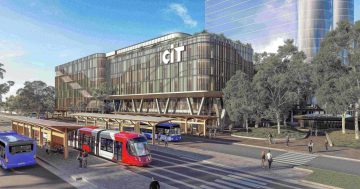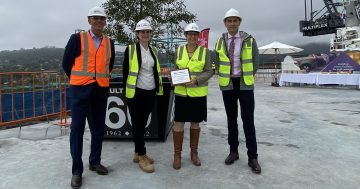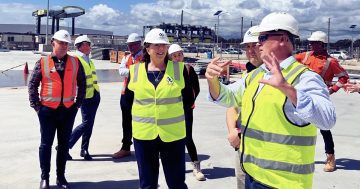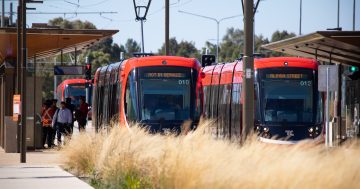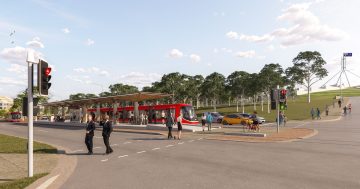
Major Projects Canberra Director-General and Chief Engineer Gillian Geraghty wants to deliver quality projects with a diverse and local workforce. Photo: Ian Bushnell.
The ACT Government’s new Chief Engineer and boss of Major Projects Canberra nearly gave it away when she started her 30-year career in the construction industry.
As a young woman in a male-dominated industry there were days when Gillian Geraghty confided to her father that it was just too hard, having to put up with the ingrained sexism.
But some tough-love advice, an insatiable curiosity and a resilience perhaps born out of carting bricks for her dad when he was a bricklayer before moving into construction got her through.
That’s been to the industry’s gain and now Canberra’s.
And for the young women wanting to pursue a career in engineering or construction, they couldn’t want for a better advocate.
“I’m very keen to see how we demonstrate that we’re improving the culture on our building sites, not only for Major Projects Canberra, but more how do we set the standard for the rest of the industry?” Ms Geraghty says.
“Some of the experiences I had when I started on a building site 30 years ago, I would hate to think that someone could experience today.”
Sadly, the percentage of women of going into engineering at university has not moved much since Ms Geraghty graduated from the University of Sydney when it was about 13 per cent.
In a sector suffering from skills shortages, that is a statistic Ms Geraghty wants to improve, and she champions a profession that can be creative and take you anywhere in the world.
But it’s more than just improving the culture on worksites. It’s also about structural changes to do with work hours, maternity leave and childcare as women juggle the twin demands of career and family.
“We have a responsibility to try and work all those barriers away,” says Ms Geraghty, who has raised a family with her husband and has had to negotiate those sorts of things for herself.
“So when we think about these big projects, do we need to think about a childcare facility nearby?”
Industry also needs to be more accommodating of older women returning to the workforce.

The International Women’s Day 2024 event at the CIT Woden Campus site with construction partners Lendlease and colleagues from Canberra Institute of Technology and Community Services Directorate. Gillian Geraghty is second from right. Photo: Major Projects Canberra.
Ms Geraghty has come to the National Capital from her hometown of Newcastle during an unprecedented public infrastructure boom, with a long pipeline of health, education, transport and cultural projects that will test the Territory’s finances and capability.
Her experience managing some of NSW’s biggest infrastructure projects after a long career in the private sector, obviously caught the headhunter’s eye.
Canberra wasn’t on Ms Geraghty’s radar, apart from being her mother’s birthplace, but on investigation the ACT Public Service’s collaborative environment and the Territory’s leadership on things such as green energy sealed the deal.
“The ACT Public Service is probably one of the most collaborative environments that I’ve worked in in my career,” she said. “And that really interests me, and how do you then use infrastructure as an enabler for that?
“I think there’s some really amazing things happening here, and I was keen to be part of that.”
MPC is also a growing team with a staff of 400 now, after absorbing ACT Property Group. Ms Geraghty may be a team player but she is putting her stamp on MPC as it changes to meet the demands of the government’s infrastructure program.
“I’ve delivered projects from you know, as the project director, but now it’s time for me to support and create teams that really do deliver great outcomes,” she says.
The acquisition of ACT Property Group offers the opportunity to transfer skills within MPC and see how they might apply to the Northside Hospital or the Canberra Theatre project.
She would also like to see MPC become more innovative than it has been, encourage more upskilling and in procurement secure more sustainable building methods and materials for projects such as the theatre redevelopment.
For critics who attack the slow pace of project delivery, in particular light rail, Ms Geraghty stresses the importance of planning and getting it right on paper before breaking ground.
“Making mistakes in construction is expensive, she says. “Making mistakes in design is much less expensive. The lines on paper are easy to fix.
“Light rail Stage 2B is a good example. Going through the designated zones of the parliamentary area, we need to be really careful.
“We’ve got heritage issues, we’ve got lighting requirements, we’ve got landmarks, sight lines. These are all the things that we need to consider, and so that’s going to take a bit of time. You can’t change a sight line once you’re in construction.”
But she believes consultation must be thorough and the public kept informed about projects that are costly and will have profound impacts on the community.
“I appreciate the public want things to happen overnight,” she says. “We need to be really clear and transparent about what we’re doing and why it’s taking a long period of time, and explain it. That’s our responsibility. We’re accountable for every dollar we spend.”
Ms Geraghty is clear though that once planning and procurement is done, projects are to be delivered on time and on budget.
Suggesting that she will be able to point to a lasting legacy across Canberra, Ms Geraghty demurs, saying it’s always about the team.
Social infrastructure projects gave her the most satisfaction in her career so it was a natural progression for her to move into the public sector where she could influence and drive the best outcomes.
For Ms Geraghty, an important part of her role beyond the actual projects is the opportunity to building communities, and nurturing a local and diverse workforce.
“It’s not just about what we’re building, it’s how are we building it and how do we create a sustainable workforce through the projects that we’re delivering?” she says. “Because I believe that if the communities who are building the projects are the communities that will occupy them, then they’ll do a great job because they care about them.”













